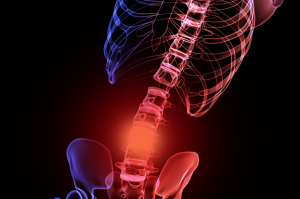 Lower back pain is one of the most common health problems in the developed world. One-time occurrence of lower back pain is found in 15–30% of the population; the 1-month prevalence is 19–43% of the population; and the lifetime prevalence is up to 60–80% of the population.
Lower back pain is one of the most common health problems in the developed world. One-time occurrence of lower back pain is found in 15–30% of the population; the 1-month prevalence is 19–43% of the population; and the lifetime prevalence is up to 60–80% of the population.
Lower back pain can be divided into two categories: specific or nonspecific. Specific lower back pain can be induced by apparent causes such as spinal tumours or infection. However, 80 or 90% of lower back pain is classified as nonspecific, without identifiable causes, and is often chronic and difficult to treat.
The 2 most common causes of back pain are lateral canal stenosis (LCS) and herniated disc (HD). LCS results from osteophyte formation, or hypertrophied zygapophyseal joints and/or ligamentum flavum. HD results from herniation of nuclear material outside the confines of the annulus fibrosis. In some cases, LCS and HD are present simultaneously.
In theory, back pain is due to excessive stimulation of pain-sensitive parts of the spine. It can be associated with lumbar disc degeneration, back trauma, disc arthritis, osteoporosis, ligament damage, infection and inflammatory type diseases. Research has identified the presence of antigen-antibody complexes in herniated discal tissue1. Crohn’s disease, renal transplants and occupations that involve exposure to excessive vibration. e.g. truck driving, are associated with increased reporting of back pain. However, more than 80% of neck and back problems are the result of tight, achy muscles, brought about by poor posture giving rise to chronic latent acidosis.
Cigarette smoking tends to aggravate back pain by increasing the ischaemia to the disc and by lowering the pain threshold. Cigarette smoke also inhibits the activity of alpha-1-antiprotease, the most potent protease inhibitor. This results in accelerated disc breakdown and degeneration, due to an imbalance between matrix proteases and their inhibitors.
Possible causes or contributing factors
- Back trauma
- Heavy physical strain, frequent lifting, postural stress and vibration
- Inflammatory type diseases
- Ligament damage
- Arthritis
- Stress (psycho – social)
- Poor blood or nutritional flow to the disc is associated with disc degeneration, as seen in abdominal aortic atherosclerosis
- Osteoporosis
- Muscle spasms
- Vitamin D deficiency, particularly in older people
- Intervertebral disc herniation.
Inflammatory mediators and pain
The biochemical mediators of inflammation include cytokines, neuropeptides, growth factors and neurotransmitters. Irrespective of the type of pain – whether it is acute or chronic pain, peripheral or central pain, nociceptive or neuropathic pain – the underlying origin is inflammation and the inflammatory response.
Biochemical causes of pain
The origin of all pain is inflammation and the inflammatory response.
Inflammatory mediators activate local pain receptors and nerve terminals and produce hypersensitivity in the area of injury. Activity of the mediators results in excitation of pain receptors in the skin, ligaments, muscle, nerves and joints. Excitation of these pain receptors stimulates the specialised nerves that carry pain impulses to the spinal cord and brain. Subsequent to tissue injury, the expression of sodium channels in nerve fibres is altered significantly, leading to abnormal excitability in the sensory neurons. These result in magnification of all nerve traffic and pain stimuli that arrive in the spinal cord from the periphery. Activation of motor nerves that travel from the spinal cord to the muscles results in excessive muscle tension. More inflammatory mediators are released which then excite additional pain receptors in muscles, tendons and joints, generating more nerve traffic and increased muscle spasms. Persistent abnormal spinal reflex transmission due to local injury or even inappropriate postural habits may then result in a vicious circle between muscle hypertension and pain.
Nutritional Treatment *
3. Nutrients that modulate protease enzyme activity, and support synthesis of matrix glycoproteins and collagen fibres
4. Reduce inflammation and oxidant stress in the affected tissues
5. Reduce exposure to truck vibration on long trips by cushioning seat appropriately
6. Cushion your walk by wearing jogging shoes
7. Regular back massage is recommended
8. If acupuncture is used, supplement with DL-phenylalanine as it increases the efficacy of the acupuncture
9. Surgery is indicated when there is compression of the nerve roots producing continuous release of inflammatory mediators, significant muscle weakness and/or urinary or bowel incontinence
10. Intramuscular vitamin B12 injections have been found to reduce back pain
11. Chronic low back pain improves with the supplementation of alkaline minerals plus alkaline diet
12. Pulse magnetic field therapy should be used to improve blood flow and decrease pain
13. Vitamin D deficiency (VDD) can result in chronic pain, osteoporosis, fractures, and muscle weakness. Supplement with vitamin D.
14. Immune regulation and support, which may include treatment of chronic microbial infections
* Never self prescribe. Always consult a qualified natural health practitioner to ensure you take quality supplements suited to your individual needs.
A natural approach
